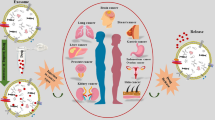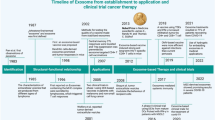Abstract
Exosomes are biological nanovesicles that are intrinsically loaded with thousands of biomacromolecules and are principally responsible for cell-to-cell communication. Inspired by the natural payload, they have been extensively investigated as drug delivery vehicles; however, the drug distribution, whether into or onto exosomes, is still debatable. In the present work, we have tried to investigate it systemically by selecting 5-fluorouracil (5-FU) (hydrophilic) and paclitaxel (PAC) (hydrophobic), drugs with very different physicochemical characteristics, for the loading to the exosomes. Exosomes were obtained from bovine milk, and the drugs were loaded using three different methods: incubation, sonication, and triton x-100. The particle size was found to be approximately 100 nm in all the cases; however, the highest drug loading was found in the sonication method. Fluorescence spectrophotometer, EDX analysis, EDX mapping, XPS, and XRD analysis indicated the possible presence of more drugs over the surface in the case of the incubation method. Drugs loaded by the sonication method had more controlled release than simple incubation and triton x-100. The method of drug loading had an insignificant effect on the cytotoxicity while in line with our previous observation, the combination (PAC and 5-FU) exhibited synergism as evidenced by ROS assay, colony formation assay, and mitochondrial membrane potential assay.
Graphical Abstract











Similar content being viewed by others
Data Availability
The authors declare that the data supporting the findings of this study are available within the paper and its supplementary information files. Should any raw data files be needed in another format, they are available from the corresponding author upon reasonable request.
References
Salehi M, Sharifi M. Exosomal miRNAs as novel cancer biomarkers: Challenges and opportunities. J Cell Physiol. 2018;233(9):6370–80.
Kandimalla R, Saeed M, Tyagi N, Gupta RC, Aqil F. Exosome-based approaches in the management of Alzheimer’s Disease. Neurosci Biobehav Rev, 2022. p. 104974.
Kumar DN, et al. Exosomes as Emerging Drug Delivery and Diagnostic Modality for Breast Cancer: Recent Advances in Isolation and Application. Cancers. 2022;14(6):1435.
Zarà M, et al. Exosomes in cardiovascular diseases. Diagnostics. 2020;10(11):943.
Fu S, et al. Exosome engineering: Current progress in cargo loading and targeted delivery. NanoImpact. 2020;20:100261.
Rizvi SA, Saleh AM. Applications of nanoparticle systems in drug delivery technology. Saudi Pharm J. 2018;26(1):64–70.
Chaudhuri A, et al. Lipid-Based Nanoparticles as a Pivotal Delivery Approach in Triple Negative Breast Cancer (TNBC) Therapy. Int J Mol Sci. 2022;23(17):10068.
Lin W. Introduction: nanoparticles in medicine. ACS Publications. Chem rev. 2015. p. 10407–10409.
Huang H-C, et al. Inorganic nanoparticles for cancer imaging and therapy. J Control Release. 2011;155(3):344–57.
Malam Y, Loizidou M, Seifalian AM. Liposomes and nanoparticles: nanosized vehicles for drug delivery in cancer. Trends Pharmacol Sci. 2009;30(11):592–9.
Wu D, et al. Profiling surface proteins on individual exosomes using a proximity barcoding assay. Nat Commun. 2019;10(1):1–10.
Kandimalla R, et al. Targeted oral delivery of paclitaxel using colostrum-derived exosomes. Cancers. 2021;13(15):3700.
Yang T, et al. Exosome delivered anticancer drugs across the blood-brain barrier for brain cancer therapy in Danio rerio. Pharm Res. 2015;32(6):2003–14.
Kim MS, et al. Development of exosome-encapsulated paclitaxel to overcome MDR in cancer cells. Nanomedicine: Nanotechnology, Biology and Medicine. 2016;12(3):655–64.
Li Y-J, et al. Gemcitabine loaded autologous exosomes for effective and safe chemotherapy of pancreatic cancer. Acta Biomater. 2020;101:519–30.
Osteikoetxea X, et al. Differential detergent sensitivity of extracellular vesicle subpopulations. Organ Biomol Chem. 2015;13(38):9775–82.
Xi X-M, Xia S-J, Lu R. Drug loading techniques for exosome-based drug delivery systems. Die Pharmazie-An Int J Pharm Sci. 2021;76(2–3):61–7.
Kumar DN, Chaudhuri A, Dehari D, Shekher A, Gupta SC, Majumdar S, Krishnamurthy S, Singh S, Kumar D, Agrawal AK. Combination therapy comprising paclitaxel and 5-fluorouracil by using folic acid functionalized bovine milk exosomes improves the therapeutic efficacy against breast cancer. Life. 2022;12(8):1143.
Munagala R, et al. Bovine milk-derived exosomes for drug delivery. Cancer letters. 2016;371(1):48–61.
Sublemontier O, et al. X-ray photoelectron spectroscopy of isolated nanoparticles. J Phys Chem Lett. 2014;5(19):3399–403.
Parvez S, et al. Modified solid lipid nanoparticles encapsulated with Amphotericin B and Paromomycin: an effective oral combination against experimental murine visceral leishmaniasis. Sci Rep. 2020;10(1):1–14.
Yang T, Cui FD, Choi MK, Lin H, Chung SJ, Shim CK, Kim DD. Liposome formulation of paclitaxel with enhanced solubility and stability. Drug Deliv.2007;14(5):301–308.
Wang Y, et al. Docetaxel-loaded exosomes for targeting non-small cell lung cancer: preparation and evaluation in vitro and in vivo. Drug delivery. 2021;28(1):1510–23.
Aqil F, et al. Exosomes for the enhanced tissue bioavailability and efficacy of curcumin. AAPS J. 2017;19(6):1691–702.
Agrawal AK, et al. Milk-derived exosomes for oral delivery of paclitaxel. Nanomedicine: Nanotechnology, Biology and Medicine. 2017;13(5):1627–36.
Yammine A, Gao J, Kwan AH. Tryptophan fluorescence quenching assays for measuring protein-ligand binding affinities: principles and a practical guide. Bio-protocol. 2019;9(11):e3253–e3253.
Yu Y, et al. Engineering of exosome-triggered enzyme-powered DNA motors for highly sensitive fluorescence detection of tumor-derived exosomes. Biosens Bioelectron. 2020;167:112482.
Stevens PJ, Sekido M, Lee RJ. A folate receptor–targeted lipid nanoparticle formulation for a lipophilic paclitaxel prodrug. Pharm Res. 2004;21(12):2153–7.
Zhang Y, et al. ICP-MS and photothermal dual-readout assay for ultrasensitive and point-of-care detection of pancreatic cancer exosomes. Anal Chem. 2021;93(33):11540–6.
Li H, et al. Artificial exosomes mediated spatiotemporal-resolved and targeted delivery of epigenetic inhibitors. J Nanobiotechnol. 2021;19(1):1–16.
Farhana FZ, et al. Isolation and detection of exosomes using Fe2O3 nanoparticles. ACS Appl Nano Mater. 2021;4(2):1175–86.
Sun M, et al. Cryo-self-assembled silk fibroin sponge as a biodegradable platform for enzyme-responsive delivery of exosomes. Bioactive Mater. 2022;8:505–14.
Zhang H, et al. A GSH Functionalized Magnetic Ultra-thin 2D-MoS2 nanocomposite for HILIC-based enrichment of N-glycopeptides from urine exosome and serum proteins. Anal Chim Acta. 2020;1098:181–9.
Wang J, Chen D, Ho EA. Challenges in the development and establishment of exosome-based drug delivery systems. J Control Release. 2021;329:894–906.
Wallenberg M, Misra S, Björnstedt M. Selenium cytotoxicity in cancer. Basic Clin Pharmacol Toxicol. 2014;114(5):377–86.
Freshney RI. Cytotoxicity. Culture of animal cells: a manual of basic technique. 2005.
Rosenberger L, et al. Stem cell exosomes inhibit angiogenesis and tumor growth of oral squamous cell carcinoma. Sci Rep. 2019;9(1):1–12.
Xu J-F, et al. Exosomes containing differential expression of microRNA and mRNA in osteosarcoma that can predict response to chemotherapy. Oncotarget. 2017;8(44):75968.
Saneja A, et al. Development and evaluation of long-circulating nanoparticles loaded with betulinic acid for improved anti-tumor efficacy. Int J Pharm. 2017;531(1):153–66.
Moloney JN, Cotter TG. ROS signalling in the biology of cancer. In: Seminars in cell & developmental biology (Vol. 80, pp. 50–64). Academic Press. 2018.
Zhang B-B, et al. Mitochondrial membrane potential and reactive oxygen species in cancer stem cells. Familial Cancer. 2015;14(1):19–23.
Reers M et al. Mitochondrial membrane potential monitored by JC-1 dye. Methods Enzymol. Elsevier; 1995. p. 406–417.
Smiley ST, et al. Intracellular heterogeneity in mitochondrial membrane potentials revealed by a J-aggregate-forming lipophilic cation JC-1. Proc Natl Acad Sci. 1991;88(9):3671–5.
Alimova IN, et al. Metformin inhibits breast cancer cell growth, colony formation and induces cell cycle arrest in vitro. Cell Cycle. 2009;8(6):909–15.
Mokhtari RB, et al. Combination therapy in combating cancer. Oncotarget. 2017;8(23):38022.
Acknowledgments
The authors are highly grateful to the Department of Pharmaceutical Engineering and Technology, Indian Institute of Technology (BHU) Varanasi, for providing Infrastructure. The authors are also thankful to the Science & Engineering Research Board (SERB), Department of Science and Technology (DST), New Delhi, India, for providing the financial support required for performing this work (Grant no SRG/2019/000150).
Funding
Science & Engineering Research Board (SERB), Department of Science and Technology (DST), New Delhi, India, has funded this work (File No. SRG/2019/000150)
Author information
Authors and Affiliations
Contributions
Dulla Naveen Kumar: conceptualization, investigation, and original draft writing; Aiswarya Chaudhuri: Methodology, review, and editing; Dinesh Kumar: Compilation and overall modification; Sanjay Singh: literature survey, review and editing; Ashish Kumar Agrawal: Conceptualization, methodology, review, editing, and supervision.
Corresponding author
Ethics declarations
Conflicts of Interest
The authors declare that they have no known competing financial interests or personal relationships that could have appeared to influence the work reported in this paper.
Additional information
Publisher's Note
Springer Nature remains neutral with regard to jurisdictional claims in published maps and institutional affiliations.
Supplementary Information
Below is the link to the electronic supplementary material.
Rights and permissions
Springer Nature or its licensor (e.g. a society or other partner) holds exclusive rights to this article under a publishing agreement with the author(s) or other rightsholder(s); author self-archiving of the accepted manuscript version of this article is solely governed by the terms of such publishing agreement and applicable law.
About this article
Cite this article
Kumar, D.N., Chaudhuri, A., Kumar, D. et al. Impact of the Drug Loading Method on the Drug Distribution and Biological Efficacy of Exosomes. AAPS PharmSciTech 24, 166 (2023). https://doi.org/10.1208/s12249-023-02624-6
Received:
Accepted:
Published:
DOI: https://doi.org/10.1208/s12249-023-02624-6




